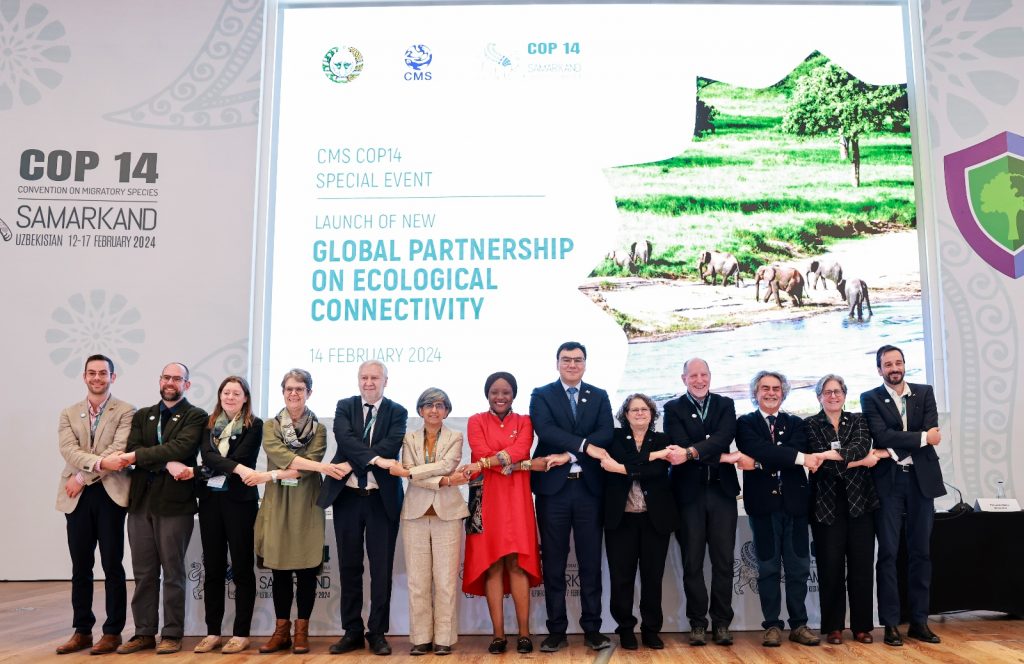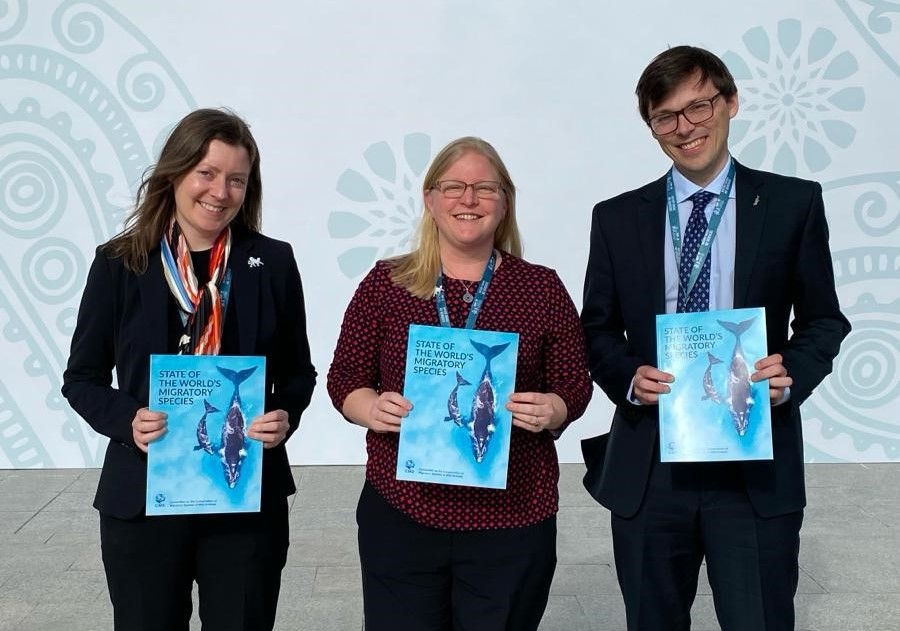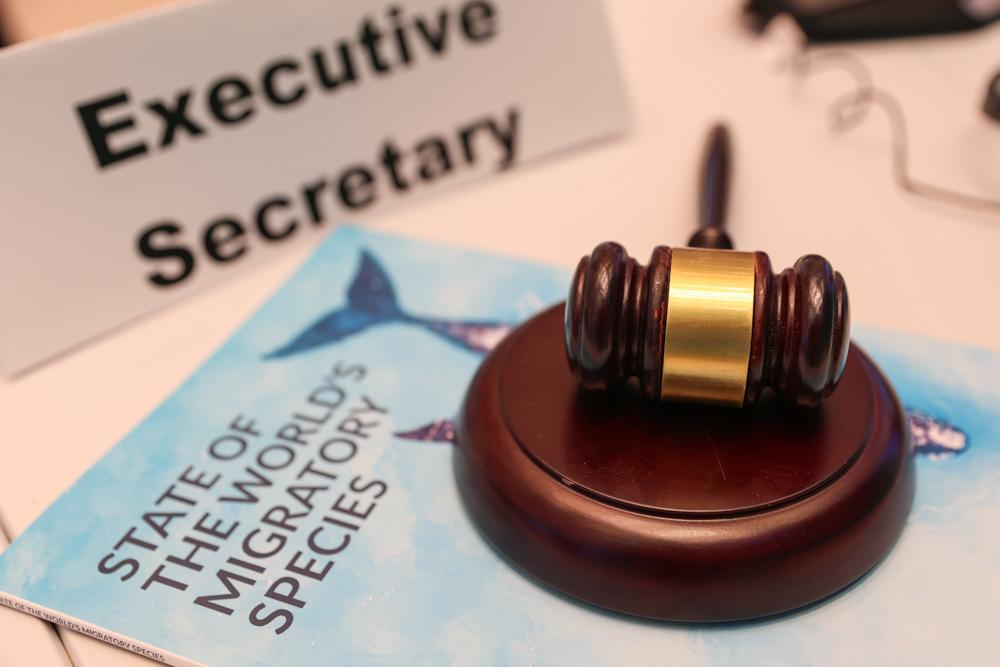News
CMS COP14: Optimism for migratory animals, if the world scales up action now

Comment | Mar 2024
UNEP-WCMC’s COP14 delegation Kelly Malsch, Frances Davis and Andrew Szopa-Comley reflect on the recent 14th meeting of the Conference of the Parties of the Convention on the Conservation of Migratory Species of Wild Animals, celebrating, in particular, the positive reception of the first comprehensive assessment on migratory species.
Last month, more than 2,000 government representatives, non-governmental observers and conservationists descended on the ancient city of Samarkand in Uzbekistan for the latest meeting of the Conference of the Parties (COP14) of the UN treaty to conserve the world’s migratory species and their habitats: the Convention on the Conservation of Migratory Species of Wild Animals (CMS).
A delegation from UNEP-WCMC was among those flocking to Samarkand. Over the course of a busy and exciting week, we launched a landmark report, presented important documents to the Parties, participated in side events and supported the launch of a vital new initiative. At the forefront of our minds were the animals with awe-inspiring migrations that now face an uncertain future: the tiny songbirds that cross entire continents; the migratory fish that course through rivers; the vast herds whose movements can be observed from space; and iconic species such as the blue whale, the largest animal on the planet, which makes trans-oceanic odysseys every year.
The theme of CMS COP14, “Nature knows no borders”, reflected the scale and transboundary nature of these epic migrations. It also underscored the crucial importance of international collaboration and cooperation in securing a better future for these species, and ultimately the entire planet. Happily, this COP did not disappoint on that front, with positive actions taken to drive forward solutions in many different areas and many Parties praising the collaborative spirit and the productivity of the week in their concluding remarks.
Delegates agreed to extend CMS Appendices protections to 14 new species, with additions including the Critically Endangered sand tiger shark and the Vulnerable Magellanic plover. These listings are bittersweet, as while positive in that they confer protection and provide impetus for action, they also signal international recognition of species’ uncertain future and the need for governments to urgently take action to improve outcomes for these species.
Concerted Actions – priority conservation measures with targeted protection plans – were approved for 13 species, including the blue shark and the straw-coloured fruit bat. Four memoranda of understanding were signed, 52 agenda items adopted, and resolutions and decisions agreed on a range of threats affecting marine migratory species, including bycatch, vessel strikes and marine noise. Representatives also agreed a forward-looking resolution on deep-sea mining that emphasises the precautionary approach and urges Parties to avoid engaging in or supporting this potentially damaging activity until the impacts are sufficiently understood.
Transboundary initiatives to identify, protect and connect migrations
One of the most exciting outcomes from COP14 was the launch of a Global Partnership on Ecological Connectivity, which brings together a broad range of organisations, including UNEP-WCMC as a core partner. Under the agreement, organisations will work together to build knowledge on connectivity and translate this into tangible actions.
Migratory species depend on networks of sites and habitats, with free movement between them essential. The first-ever CMS State of the World’s Migratory Species report – prepared by UNEP-WCMC conservation scientists with the CMS Secretariat – reveals that nearly half of the world’s migratory species have decreasing populations and highlights the perilous state of migratory fish, including sharks, rays and freshwater fish. It provides a clear overview of the threats they face – and the actions needed to turn the tide for these species. It also highlights that while many sites are known, many are not protected, and many have not been identified or mapped.
The Global Partnership on Ecological Connectivity seeks to ensure that important areas for migratory species are identified, protected and connected. Building on this further, our Connectivity Conservation Lead Frances Davis presented at a side event aimed at helping countries implement policies for ecological connectivity.

Other key outcomes included the launch of the Initiative for the Central Asian Flyway. Covering 30 countries in North, Central and South Asia, this initiative fills a major global gap in facilitating conservation action for migratory birds, and is expected to galvanise efforts to halt the decline of species like the Endangered steppe eagle.
Throughout the COP, there was an increased focus on tackling the drivers of illegal and unsustainable hunting, which represents a major threat causing declines in many migratory populations – and was highlighted in our assessment considered by the Parties.
UNEP-WCMC launches landmark report at COP14
One of the most significant moments for our team at COP14 was the launch of the CMS State of the World’s Migratory Species report, mentioned earlier.

We were struck by the attention our report received in the media: more than 3,000 publications covered it globally, showing how migratory species capture the public’s imagination. With the world looking on, the meeting had a heightened urgency which spurred on the delegates to act. We were also inspired by the array of ambitious conservation initiatives highlighted both in the report and throughout the week that bring people from different countries and regions together to find innovative solutions to protect and conserve migratory species.
The State of the World’s Migratory Species report identified 399 Globally Threatened and Near-Threatened migratory species that may benefit from protection under CMS, including many freshwater fish. Delegates to COP14 agreed that a more strategic approach to listing proposals is needed. It is hoped that bringing this to light will help Parties to cover more species under the fold of CMS and provide a much-needed scientific underpinning for Parties to prioritise future listings.
Crucially, many of the key recommendations outlined in the report are closely aligned with the goals and targets in the newly adopted Samarkand Strategic Plan for Migratory Species. This sets the key goals of the Convention for the next eight years, with clear ambitions on conservation status, habitat connectivity and threats, which are aligned with the Kunming-Montreal Global Biodiversity Framework. Recommendations highlighted in our report - and given prominence in the strategic plan - include the need to individually tackle the varied pressures facing these animals, and the importance of identifying, monitoring and protecting critical sites. The adoption of the new Strategic Plan will help to drive forward these priorities and guide actions over the next eight years.
Following the success of the launch, it was agreed that the report will be repeated every six years, at alternate COPs, starting at COP16. UNEP-WCMC looks forward to continuing to assist the CMS Secretariat in this important work.

Main image: A painting of a snow leopard by Uzbek artist Inkuzart at the venue for COP14 in Uzbekistan. The snow leopard is a keystone species in Uzbekistan and was therefore chosen as main symbol of the COP14 logo. (Image: Kelly Malsch)
Have a query?
Contact us
communications@unep-wcmc.org
